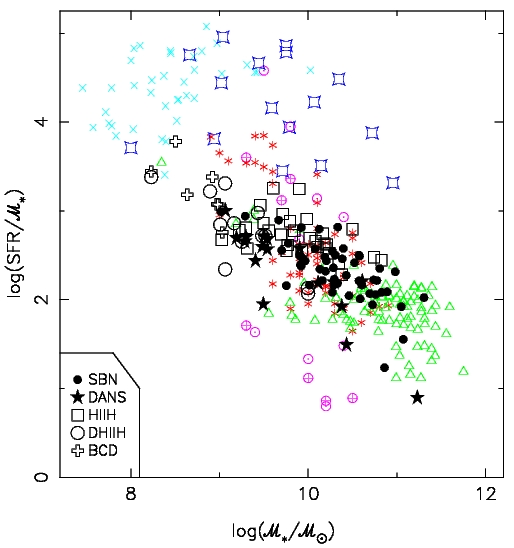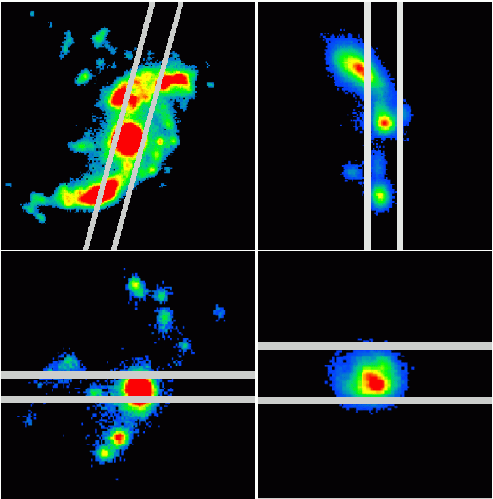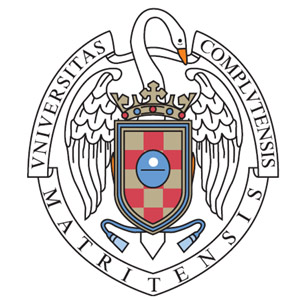In my PhD thesis, presented in June 2003, I compiled broad- and narrow-band optical and near-infrared data for the 191 galaxies in the UCM Survey. The UCM Survey selected by their Hα emission a representative sample of star-forming galaxies in the local Universe. This sample has been used extensively as a the local benchmark for studies of galaxies at intermediate and high redshift (see, e.g., Gallego et al. 1995).
With the complete dataset for the UCM galaxies, I studied the main properties of the stellar populations in the local star-forming galaxies and the global properties of the star formation in the local Universe. For that purpose, we developed a code for stellar population synthesis studies. This code combines the emission from stars (with the possibility of including different populations with different properties) and gas and compares the models with the observed data using a Bayesian technique that provides the most probable values of properties such as the age of the stellar population, the metallicity, or the stellar mass.


 and a specific SFR of 100-1000
yr-1. There are 2 main categories among the local
star-forming galaxies: 1) some massive galaxies with
enhanced star formation in their disks (probably linked to
interactions with other galaxies), which typically harbor
star formation bursts with high metallicities and low
ionizations (filled black symbols in the figure); and 2)
less massive galaxies with more intense bursts which
typically present low metallicities and high ionization
estates (open black symbols in the figure). The former type,
known as disk-like star-forming galaxies, are closer to
normal quiescent spiral galaxies (for example, the ones in
Kennicutt 1983 sample, shown
as green triangles). The other type of local star-forming
galaxies are known as HII-like objects, and they are closer
to some of the objects in the Universe with the most violent
star formation, such as HII galaxies (Telles 1995; cyan crosses) or
UV-bright starbursts (Calzetti 1997; blue
rectangles).
and a specific SFR of 100-1000
yr-1. There are 2 main categories among the local
star-forming galaxies: 1) some massive galaxies with
enhanced star formation in their disks (probably linked to
interactions with other galaxies), which typically harbor
star formation bursts with high metallicities and low
ionizations (filled black symbols in the figure); and 2)
less massive galaxies with more intense bursts which
typically present low metallicities and high ionization
estates (open black symbols in the figure). The former type,
known as disk-like star-forming galaxies, are closer to
normal quiescent spiral galaxies (for example, the ones in
Kennicutt 1983 sample, shown
as green triangles). The other type of local star-forming
galaxies are known as HII-like objects, and they are closer
to some of the objects in the Universe with the most violent
star formation, such as HII galaxies (Telles 1995; cyan crosses) or
UV-bright starbursts (Calzetti 1997; blue
rectangles).
This is another figure from my thesis, which shows
Hα images of 4 UCM Survey galaxies. In Jesús Gallego's thesis
(1995), long-slit spectra were obtained for all the
UCM sample (see also Gallego et al. 1996). For my
thesis, we obtained narrow-band Hα images for a
representative subsample of UCM galaxies to measure how
much star formation for each galaxy was not detected by
the long slits. In the figure below, we show the positions
of the lon-slits used by Gallego et al. 1996. Our
results indicate that typically 50% to 70% of the total
Hα flux of a UCM galaxy is extended, so it falls out
of a long-slit. Using this correction, we re-estimated the
cosmic SFR density at z=0 (Pérez-González et
al. 2003), obtaining a value of
0.029+0.008-0.005 
 yr-1Mpc-3 for a cosmology with
H0 = 70 km
s-1 Mpc-1,
yr-1Mpc-3 for a cosmology with
H0 = 70 km
s-1 Mpc-1,  M = 0.3, and
M = 0.3, and
 = 0.7 (for comparison, Gallego et al. 1995 obtained
a value of 0.021
= 0.7 (for comparison, Gallego et al. 1995 obtained
a value of 0.021 
 yr-1Mpc-3
for the same cosmology).
yr-1Mpc-3
for the same cosmology).


